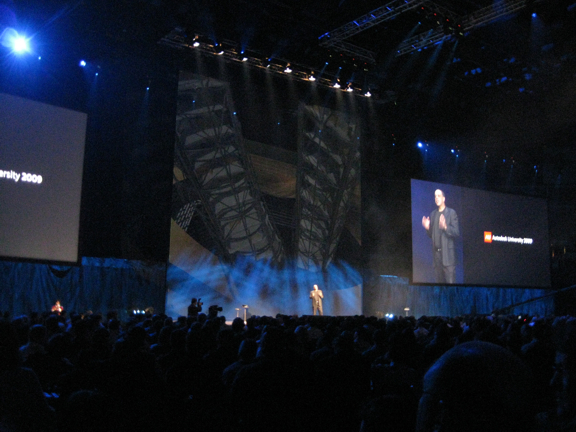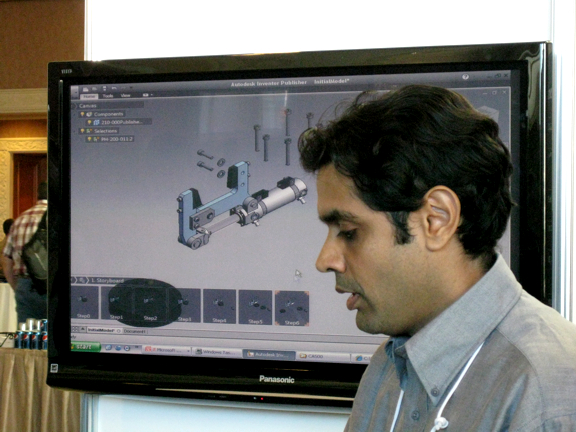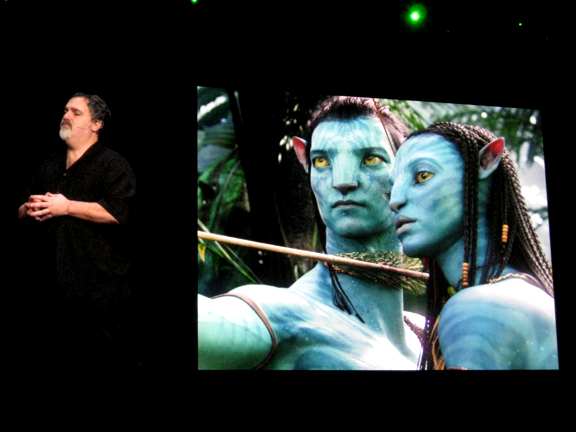Latest News
December 4, 2009

One might think that, with 6,000 customers gathering under the same roof for Autodesk University 2009 (AU 2009), Autodesk would take the opportunity to entice them with revelations of what they could expect in upcoming versions. That was not the case this year, however. In most keynotes, presenters were rather conservative in what they had to say about the future of their product lines. (As a public company, Autodesk has to be careful about previewing ongoing R&D efforts that might be interpreted as promises, some of the executives later explained to me.)
That made Inventor Publisher an exception. Soon after company president and CEO Carl Bass delivered his opening speech, Autodesk announced the public availability of Inventor Publisher as a technology preview in Autodesk Labs. The software is meant as a tool for publishing 3D documents and animations. Initially, the code was released for both 32 bit and 64 bit Windows, but the 64 bit version was soon taken offline due to technical issues. The issue has since been resolved, according to Scott Sheppard from Autodesk Labs, and 64-bit version is back online. If Inventor Publisher becomes a standalone commercial package, it may compete with 3DVIA Composer from Autodesk rival Dassault Systemes.
Other revelations came in carefully prepared sentences and slides (approved by legal department, no doubt), with no explicit mention of when or where they might make their public debut.

Computer Finally Lends a Hand
In his round up of technology trends, Brian Matthews, vice president of Autodesk Labs, pointed out, “Real engineering takes place in the brain; we used the computer only to document the idea after the fact ... but now computers have become smart enough to really be an aid in design.”
He suggested that, using analysis algorithms and increased computing power (perhaps via cloud computing), we may simply input the maximum load or stress for a part, then let the software run multiple simulation sessions to determine the best option for the design. (It was a workflow Mathews’ boss Bass had similarly hinted during last year’s AU keynote address.) In my personal view, implementing such a capability might involve reworking ALGOR’s code to take advantage of cloud computing.
Your 3D Part Just Sent You a Tweet
The headline for a BBC news story dated June 6, 2009, read, “Lost plane ‘sent 24 error alerts.’ ” It was a reference to the automatic radio messages dispatched by Air France 447’s onboard maintenance system, just before the plane disappeared.
In his keynote, Bass asked the audience to imagine a collaboration environment, one that borrows many relevant features from social networking applications like Facebook, where parts and components might automatically issue alerts about possible clashes or collisions with other parts. The introduction of such a technology could reduce errors in multi-user mechanical assemblies and architectural models (commonly called BIM, or building information models).
AutoCAD’s Untold StoryAutoCAD, Autodesk’s bread and butter, has a long history rooted in drafting and drawing. This legacy may be the reason the software has long been type-casted as a 2D workhorse. In Release 2010, AutoCAD introduced a slew of 3D tools, including freeform mesh-modeling. (Read David Cohn’s review of the software here.)
In the industry keynote titled “AutoCAD and Media & Entertainment,” copresenters Marc Petit, senior VP of Autodesk Mmedia & entertainment (M&E), and Amar Hanspal, senior VP of platform solutions, did their best to shine a spotlight on AutoCAD’s 3D persona.
It was a Hollywood-size spotlight, immediately followed by a stereoscopic preview of select scenes from James Cameron’s upcoming cinematic epic Avatar. Producer John Landau from Lightstorm revealed that, in making the movie, Cameron has used Autodesk MotionBuilder software to direct scenes that take place in the fictional world (dubbed Pandora) using a virtual camera.

Sustainable HelpAmong Autodesk spokespersons available for one-on-one interviews with the media this year were Emma Stewart, Autodesk’s senior program lead of sustainability initiative, and Dawn Danby, Autodesk’s sustainable design program manager. Also present at the conference was Lynelle Cameron, Autodesk’s director of sustainability. She led the Sustainability Tour for the press, to introduce Autodesk’s partnership with Sustainable Minds, among other things. (For more on this partnership, read my previous blog posts here and here.)
The green task force’s participation has reshaped AU in several ways. Noticeably, it began using compostable utensils, conference catalogs printed on post-consumer waste paper, and dufflebags sewn with recycled nylon materials. Those and other corporate efforts would contribute to reducing the carbon footprint of AU conference, which is estimated to be 8,000 metric tons, according to Dawn Danby.
AutoCAD’s carbon footprint, for that matter, comes to about 2.331 metric tons per each package sold. By comparison, if you choose to download the code instead, you would help reduce the software’s carbon count to 0.461 metric tons, a hefty 80% decrease. The estimation takes into account energy used during product assembly and transportation, among others. (For a detailed breakdown, see the chart here from Autodesk.)
For users of its mechanical software Autodesk Inventor, the company has recently released a plug-in called Sustainable Materials Assistant, a tool to help manufacturers make more environmentally responsible material choices.
Perhaps Autodesk Labs, where the company lets users test-drive its tools and technologies still in development, offers a better view of the near future of Autodesk products. At AU this year, you need to use a mix of active imagination and deductive reasoning to visualize new features coming to a product near you.
For more, read Part I and watch the video report below:
Subscribe to our FREE magazine, FREE email newsletters or both!
Latest News
About the Author
Kenneth Wong is Digital Engineering’s resident blogger and senior editor. Email him at [email protected] or share your thoughts on this article at digitaleng.news/facebook.
Follow DE





